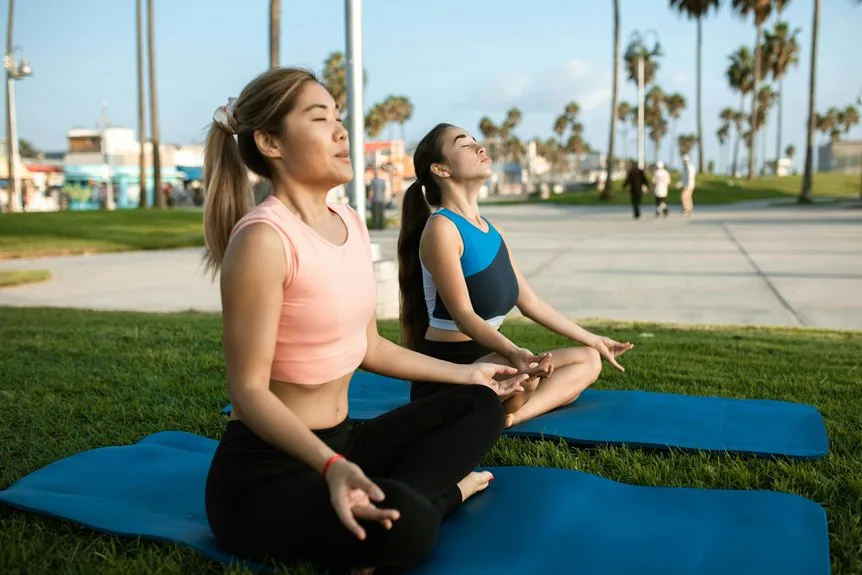Guided meditation for better sleep is a practice where a soothing voice leads listeners through calming exercises, like breathing deeply or imagining peaceful scenes, to help the mind unwind before bed. It’s like having a gentle coach for relaxation, using soft music or nature sounds to make drifting off easier. Many people find this approach surprisingly helpful for easing stress and quieting restless thoughts, but what actually makes these sessions work so well?
Understanding Guided Meditation for Sleep
Ever wondered why it’s so hard to quiet the mind at bedtime? Guided meditation for sleep offers a welcoming path, using audio recordings that lead listeners through relaxation techniques like body scans, focused breathing, or calming visualizations. These sessions, lasting 20 to 40 minutes, help people feel connected and less alone in their struggle for better sleep quality. Gentle narration and soothing music help shift attention away from racing thoughts. Research shows that guided meditation activates the parasympathetic nervous system, lowering heart rate and blood pressure, making it easier to drift off. It’s like a gentle invitation to rest, together. Situated at the head of the Silverado Trail, Calistoga Motor Lodge & Spa offers a serene environment that complements the relaxation from guided meditation.
How Guided Meditation Promotes Restful Sleep
Guided meditation works wonders for sleep by helping to quiet a racing mind, so those endless to-do lists and worries don’t tag along to bed. It uses gentle techniques like deep breathing and visualization, which signal the body to relax and let go of tension. Incorporating such practices as part of a contemporary wellness destination like Two Bunch Palms can further enhance the experience, offering a tranquil environment that complements the meditative process.
Calming the Racing Mind
A restless mind can feel like a hamster running endlessly on its wheel, especially when it’s time to wind down for sleep. Guided meditation steps in as a gentle friend, helping individuals shift focus away from stress and racing thoughts. Through mindfulness techniques—like noticing breath, soothing imagery, or gentle body scans—the mind is invited into a state of calm. This sense of relaxation makes it easier to break free from mental chatter. As worries fade, the community of guided meditators uncovers a shared sense of peace, paving the way for restful sleep and helping everyone feel they truly belong. At Sensei Porcupine Creek, guests can experience personalized wellbeing journeys guided by trained professionals, enhancing their meditation practice for deeper relaxation.
Activating Relaxation Response
Once the whirlwind of thoughts starts to slow, something interesting happens in both the mind and body. Guided meditation activates the parasympathetic nervous system, which is like flipping a switch from “stress mode” to “rest mode.”
This shift sparks the relaxation response, helping muscles loosen, breathing deepen, and heart rate slow. As stress reduction takes hold, cortisol drops, and those familiar feelings of tension begin to fade.
Over time, regular practice encourages brain regions linked to sleep quality to work better together. People often report falling asleep quicker and waking up feeling more rested—proof that calm truly can be shared. Just as Roman Spa Hot Springs Resort offers a dedicated staff for relaxation and pleasure, guided meditation similarly provides a dedicated practice for calming the mind and body.
Key Components of a Guided Sleep Meditation
A good guided sleep meditation brings together a few essential pieces: relaxation and body awareness, steady breathwork paired with mindfulness cues, and soothing visuals with calming sounds.
Listeners are gently guided to notice each part of their body, tune in to their breathing, and envision peaceful scenes, all while calming narration sets the tone.
These elements work together like a lullaby for the mind, helping worries take a back seat as sleep becomes easier to reach.
Relaxation and Body Awareness
Guided sleep meditations often lean on the soothing power of relaxation and body awareness, two key ingredients that help turn down the brain’s volume at bedtime.
Through mindfulness meditation, individuals are encouraged to focus on physical sensations and practice a body scan, which means systematically noticing each muscle group. This method helps melt away tension, letting sleep come more easily.
Research supports that combining body awareness with relaxation techniques can lower anxiety and promote a sense of togetherness in the sleep voyage.
- Systematic body scan to notice sensations
- Focused relaxation for each muscle group
- Mindfulness meditation to anchor attention
Breathwork and Mindfulness Cues
Few things quiet a restless mind at night quite like intentional breathwork paired with gentle mindfulness cues.
When guided sleep meditations introduce slow, rhythmic breathing, such as the 4-7-8 method, they invite the body to activate its natural relaxation techniques.
Mindfulness cues—like noticing the rise and fall of the chest or simply counting each breath—help anchor attention in the present moment.
This combination reduces stress and calms racing thoughts, making it easier for people to feel connected and supported as they drift off.
Studies show these simple steps can greatly improve sleep quality and shorten the time it takes to fall asleep.
Soothing Imagery and Sound
Once the breath slows and the mind begins to settle, another key ingredient comes into play: soothing imagery and sound. Guided sleep meditations often paint peaceful scenes in the mind, paired with calming sounds, to help everyone feel safe and connected as they drift off.
These relaxation techniques draw on visualization and gentle narration, weaving comfort into every word. Here’s how it usually unfolds:
- Peaceful vistas or calming scenes are described for vivid visualization.
- Calming sounds—like gentle rain or soft music—fill the background.
- Narration uses slow, soothing tones, inviting deeper relaxation and belonging.
Common Techniques Used in Sleep Meditation
A restful night’s sleep can sometimes feel out of reach, but there are several tried-and-true techniques used in sleep meditation that can make drifting off much easier. Many people use a body scan, slowly tuning into each body part, letting go of tension bit by bit.
Breathing techniques, like deep or rhythmic breaths, help calm the mind and steady the heart. Visualization encourages imagining peaceful places, such as a quiet beach or a gentle forest, creating a sense of safety and calm.
Mantra repetition, with soothing words or sounds, quietly steers the mind away from worries, inviting true relaxation.
Benefits of Practicing Guided Meditation at Bedtime
Settling into bed after a long day, many people find their minds racing just when they crave rest the most. Guided sleep meditation offers a gentle way to ease into relaxation, helping to quiet those busy thoughts.
This practice isn’t just about feeling calm—it’s proven to support better sleep quality and reduce insomnia. Consider these key benefits:
- Guided sleep meditation helps decrease the time it takes to fall asleep, making bedtime less stressful.
- It reduces brain chatter and obsessive thoughts, allowing for deeper rest.
- Long-term use can lead to stable sleep patterns and brighter moods.
Guided Meditation vs. Other Sleep Strategies
When comparing guided meditation to classic sleep strategies like keeping a cool room or sticking to a set bedtime, the differences are easy to spot—guided meditation gives direct, calming instructions that help quiet the mind right away.
Studies show that this approach can actually work better than just following sleep hygiene rules, especially for people struggling to fall asleep due to racing thoughts.
For even better results, many find that mixing guided meditation with other healthy sleep habits can create a powerful, restful routine that’s hard to beat.
Effectiveness Compared to Sleep Hygiene
Curiously, while many people try classic sleep hygiene tricks—like turning off screens, keeping a cool bedroom, or sticking to a strict bedtime—guided meditation seems to offer something extra when it comes to getting real rest.
Research suggests guided meditation doesn’t just tweak routines; it targets the mind, helping folks unwind and drift off faster. When comparing guided meditation to sleep hygiene, studies highlight these standout differences:
- Guided meditation improves sleep quality, especially in older adults.
- It shortens sleep onset and increases total sleep time.
- Its mental focus provides lasting benefits, while sleep hygiene depends more on constant effort.
Combining Strategies for Results
Many people find that guided meditation offers a unique enhancement to their nightly routine, but the story doesn’t end there. For those seeking true sleep improvement, combining strategies is key.
Guided meditation’s relaxation techniques—like body scans and deep breathing—work even better when paired with solid sleep hygiene, such as a regular bedtime and less screen time.
Studies show that adding other methods, like progressive muscle relaxation or tweaking the bedroom environment, amplifies sleep quality further.
While guided meditation alone helps, mixing it with these habits creates a stronger sense of belonging to a healthy sleep community, leading to deeper rest.
Step-by-Step Guide to Doing Guided Sleep Meditation
A solid night’s sleep often starts with a simple, intentional routine, and guided sleep meditation makes it easy to wind down.
For those craving a sense of belonging and calm, here’s how to start this soothing practice:
- Find a quiet, cozy spot, put away screens, and pick a guided meditation for sleep—audio usually lasts 20–30 minutes.
- Lie back comfortably, close your eyes, and let the guide’s voice lead you, focusing on breathing, body sensations, or peaceful imagery.
- Practice nightly; over time, relaxation deepens and sleep improves, making bedtime feel like a shared, supportive ritual.
Popular Guided Meditation Methods and Apps
Three standout guided meditation methods have quickly become favorites for anyone hoping to drift off with less tossing and turning. Guided meditation apps like Calm, Headspace, and Insight Timer offer sleep meditations packed with soothing narrations, calming music, and gentle visualizations.
Each relaxation technique—whether it’s a body scan, deep breathing, or peaceful imagery—guides users toward better sleep quality. These apps often include customizable session lengths, prompts, and even sleep tracking, making it easy to build a comforting bedtime routine.
Regular use has shown to ease insomnia and help people feel connected to a community of fellow restful sleepers.
How Meditation Affects the Body and Mind During Sleep
When someone settles in for a guided meditation before bed, the body and mind start to shift gears in ways that set the stage for restful sleep. Guided meditation activates the parasympathetic nervous system, calming the body and lowering heart rate.
At the same time, brain activity progresses from busy beta waves to slower alpha and theta waves, which help people drift toward sleep.
Plus, meditation encourages the release of helpful hormones while lowering the stress hormone, cortisol.
Here’s how it all comes together:
- Deep relaxation through the parasympathetic nervous system
- Calmer brain activity patterns
- Balanced sleep-regulating hormones
Who Can Benefit Most From Guided Sleep Meditation
For anyone who has ever stared at the ceiling, wide awake and counting sheep that stubbornly won’t jump the fence, guided sleep meditation might just be the missing piece of the bedtime puzzle.
People dealing with insomnia or frequent racing thoughts can use guided sleep meditation to calm their minds and improve sleep. Those facing anxiety, sleep disorders, or even chronic pain often find deep relaxation through guided sessions.
Older adults, especially those with age-related sleep disturbances, may benefit as well, enjoying more restful nights.
Even individuals recovering from trauma or depression can find comfort and stability in this simple nightly practice.
Tips for Creating a Calming Bedtime Meditation Routine
A calming bedtime meditation routine doesn’t have to be complicated or time-consuming, and even small changes can make a big difference in how easily sleep comes. Creating a calming environment is key—dim the lights, quiet the space, and maybe add a hint of lavender for those relaxation cues.
Guided meditations work best when they’re part of a consistent routine, so try to meditate at the same time each night. To get started:
- Choose a comfortable, quiet space free from interruptions.
- Begin with short guided meditations, then gradually increase the duration.
- Add breathing exercises or body scans to deepen relaxation.
Addressing Challenges and Common Concerns
Even the most thoughtfully crafted bedtime meditation routine can face a few bumps along the path. Common concerns like trouble focusing, feeling restless, or struggling with staying asleep are normal, especially when starting something new. Guided audio can offer meditation help by keeping attention gently anchored, making it easier to relax.
For some, emotional discomfort or mood swings might pop up—if this happens, reaching out to a healthcare provider is smart. Remember, everyone’s voyage is unique. Finding what works best may take time, but help is available.
Staying patient and open to tweaks can make the experience feel more welcoming.
Enhancing Sleep Quality With Consistent Meditation Practice
How does something as simple as meditation end up making such a big difference in the way a person sleeps? For many, the answer lies in consistent practice and the gentle power of guided sleep. Regularly using relaxation techniques can help calm the mind, creating a sense of belonging to a nightly routine that feels both safe and comforting.
Here’s how consistent meditation enhances sleep quality:
- It reduces stress, calming the nervous system for deeper rest.
- It shortens the time needed to fall asleep and limits waking up at night.
- It helps regulate circadian rhythms, making sleep more satisfying.
Frequently Asked Questions
What Is Guided Meditation for Sleep?
Guided meditation for sleep involves breathing exercises, relaxing visuals, mental imagery, and body scan techniques. This practice helps individuals feel supported, encouraging a sense of comfort and belonging as they shift into restful sleep and improved well-being.
Which Meditation Is Good for Sleep?
Like a gentle lullaby, Yoga Nidra, body scans, and mindful breathing exercises cultivate deep relaxation. When paired with sleep hygiene and mindfulness practices, these guided meditations create a comforting sense of community, supporting restful sleep for all seekers.
Is 20 Minutes of Meditation Equal to 4 Hours of Sleep?
The current question examines whether a meditation duration of 20 minutes matches four hours of sleep. Research shows relaxation techniques improve sleep quality and support mental health, but meditation cannot biologically substitute the restorative effects of adequate sleep duration.
What Does Guided Meditation Involve?
Guided meditation gracefully guides groups through grounding breathing techniques, vivid visualization exercises, and intentional body scan routines, often accompanied by calming music. This collective experience cultivates a sense of serenity and shared solace, nurturing connection and restful relaxation.
Final Thoughts
Guided meditation for sleep isn’t just a bedtime trend—it’s like a magic wand for restless minds. By weaving together calming narration, gentle breathing, and soothing imagery, it helps even the busiest brains unwind, clearing the path for truly restful nights. With regular practice, anyone can trade in their tossing and turning for peaceful slumber. It’s not about perfection, but about finding a little more calm each night—because everyone deserves sleep that feels downright legendary.







